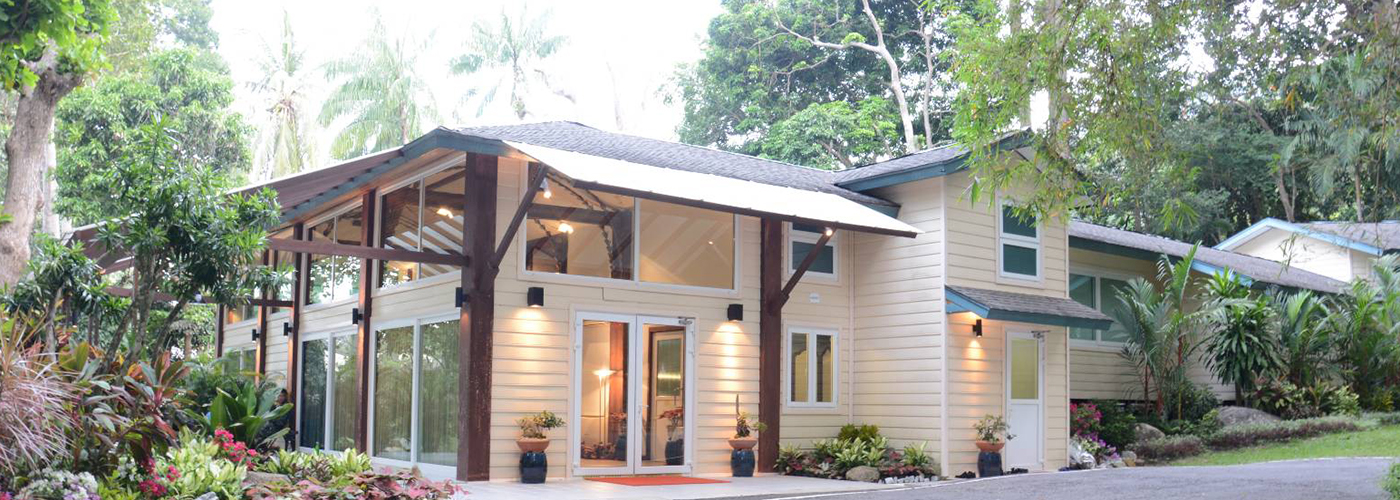
Thaksin Rajanives Palace
Thaksin Rajanives Palace is a provincial palace under the supervision of the Bureau of the Royal Household. It is located at Moo 4 Kaluwo Neua Sub-district, Muang District, Narathiwat Province, on the east coast of the peninsula, set against the eastern slope of Tanyong Mountain – the highest in the south which rises to 300m. The main royal villa is at the foot of the hill, at 50 m above sea level, so it is possible to say that the palace is located by the sea and also at the foot of a mountain. It is located on what used to be Khao Tanyong Village, inhabited by local Thai Muslims. In 1971, King Rama IX surveyed the environs of Tanyong Mountain, and wished to build a palace on the east slope of the mountain. The local Muslim villagers all agreed to sell their land to the Crown Property Bureau to build the palace. The villagers rebuilt their village just south of the palace where they live until today.
The Crown Property Bureau
Construction of Thaksin Rajanives Palace began in 1972, with the residence of the present king. The land that used to be the Muslim cemetery was not touched so as to allow the local people to perform annual religious rites for their ancestors. His Majesty also ordered the planting of bougainvillea of different colours all around the cemetery, and named it “Bougainvillea Cemetery”. Their Majesties King Bhumibol Adulyadej and Queen Sirikit took up residence at this palace for the first time on 1 August 1972, returning in September almost every year.
After the first royal villa was completed in 1973, the construction of Sala Bulan pavilion began in 1975 as the royal activities hall. In 1976, the Supreme Command Headquarters commissioned Siam Commercial Corporation Co Ltd to survey and construct a wire mesh fence and sea wall along the coastline to the east of the palace’s middle zone. These were completed in 1979. On 3 July 1981, Princess Srinagarindra The Princess Mother took up residence at Thaksin Rajanives Palace in the first royal villa, and requisitioned a petanque court north of Sala Bulan so she could play with her courtiers. This petanque court has now made way for the main royal villa. When the Princess Mother left on 29 July 1981, Preeda Construction Co Ltd began the construction of the new royal villa designed by M.L.Santhaya Israsena. The construction was supervised by Suchet Chaoreua. In 1982, King Rama IX and Queen Sirikit skipped their annual sojourn to Thaksin Rajanives Palace due to the ongoing construction, but they did take up residence in the new royal villa for the first time on 19 August 1983, staying until 3 October 1983.
The Royal Palace Compound
Thaksin Rajanives Palace is divided into 3 zones: the outer, middle and inner zones, covering a total area of 232 rai. Here it is prohibited to cut down trees, destroy forests, shoot or trap wild animals on Tanyong Mountain. Another 2,687 rai, which has also been designated part of the palace grounds on the mountain, has a building for high-ranking monks who are invited for religious retreats, This is located at about 60m above sea level, to the west of the royal villa.
Geographical environment
The geographical landscape and climate of Tanyong Mountain is lush jungle full of mature trees and abundant wildlife, from Asian black bears, deer and civet to jungle fowl, monkey and langur as well as numerous other small animals. During the rainy season, there are several waterfalls, though the water does not flow all year round. The rains begin in May, with heavy rainfalls from November to April. During the monsoon season, the wind and waves are very strong, and salt water sprays reach the palace compound, posing a threat to plant life. March and April are extremely hot, but there is no cool season. The climate in general is quite cool and pleasant.
Landscape
Each of the provincial palaces has a different landscape design. The gardens at Thaksin Rajanives Palace comprise a Rock Garden planted with mostly ferns since this area is under the shadow of large trees with little sunlight for flowering shrubs. Indigenous plants at Thaksin Rajanives Palace include Joey palm trees, Golden Gardenia and Torch Ginger. In the inner zone there is a wildlife propagation centre for rare wildlife, and bird cages for birds that are near extinction. Among the birds and animals under this royal initiative project are the White-rumped Shama, mouse deer and jungle fowl which are rare indigenous species. The goal is to breed them and release them back into the wild.
Thaksin Rajanives Palace Organisation Chart
Thaksin Rajanives Palace was under the supervision of the Crown Property Bureau which took care of all royal palaces from 1973. Then, in 1982, this responsibility was transferred to the Bureau of the Royal Household. Temporary staff are employed, paid by the King’s personal funds. It was not a government agency. On 1 March 1988, the Bureau of the Royal Household established Thaksin Rajanives Palace as a government agency responsible for supervising the palace. Today, the organisation chart of Thaksin Rajanives Palace, still under restructuring, is divided into two departments: Administration; and Buildings and Systems. There are six divisions: Administration and Finance; Storage; Vehicles; Housekeeping Staff; Systems and Utilities; and Gardens. They all answer to the Thaksin Rajanives Palace Director.
